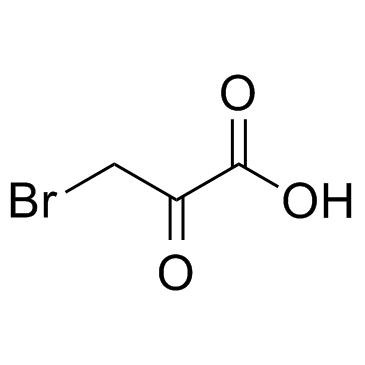Regulation of death induction and chemosensitizing action of 3-bromopyruvate in myeloid leukemia cells: energy depletion, oxidative stress, and protein kinase activity modulation.
Eva Calviño, María Cristina Estañ, Carlos Sánchez-Martín, Rocío Brea, Elena de Blas, María del Carmen Boyano-Adánez, Eduardo Rial, Patricio Aller
Index: J. Pharmacol. Exp. Ther. 348(2) , 324-35, (2014)
Full Text: HTML
Abstract
3-Bromopyruvate (3-BrP) is an alkylating, energy-depleting drug that is of interest in antitumor therapies, although the mechanisms underlying its cytotoxicity are ill-defined. We show here that 3-BrP causes concentration-dependent cell death of HL60 and other human myeloid leukemia cells, inducing both apoptosis and necrosis at 20-30 μM and a pure necrotic response at 60 μM. Low concentrations of 3-BrP (10-20 μM) brought about a rapid inhibition of glycolysis, which at higher concentrations was followed by the inhibition of mitochondrial respiration. The combination of these effects causes concentration-dependent ATP depletion, although this cannot explain the lethality at intermediate 3-BrP concentrations (20-30 μM). The oxidative stress caused by exposure to 3-BrP was evident as a moderate overproduction of reactive oxygen species and a concentration-dependent depletion of glutathione, which was an important determinant of 3-BrP toxicity. In addition, 3-BrP caused glutathione-dependent stimulation of p38 mitogen-activated protein kinase (MAPK), mitogen-induced extracellular kinase (MEK)/extracellular signal-regulated kinase (ERK), and protein kinase B (Akt)/mammalian target of rapamycin/p70S6K phosphorylation or activation, as well as rapid LKB-1/AMP kinase (AMPK) activation, which was later followed by Akt-mediated inactivation. Experiments with pharmacological inhibitors revealed that p38 MAPK activation enhances 3-BrP toxicity, which is conversely restrained by ERK and Akt activity. Finally, 3-BrP was seen to cooperate with antitumor agents like arsenic trioxide and curcumin in causing cell death, a response apparently mediated by both the generation of oxidative stress induced by 3-BrP and the attenuation of Akt and ERK activation by curcumin. In summary, 3-BrP cytotoxicity is the result of several combined regulatory mechanisms that might represent important targets to improve therapeutic efficacy.
Related Compounds
| Structure | Name/CAS No. | Molecular Formula | Articles |
|---|---|---|---|
 |
3-Bromopyruvic acid
CAS:1113-59-3 |
C3H3BrO3 |
|
3-Bromopyruvate: A novel antifungal agent against the human ...
2013-05-03 [Biochem. Biophys. Res. Commun. 434(2) , 322-7, (2013)] |
|
Inhibition of glucose turnover by 3-bromopyruvate counteract...
2014-07-15 [Oncotarget 5(13) , 5177-89, (2014)] |
|
Insights into the carboxyltransferase reaction of pyruvate c...
2013-11-01 [Biochem. Biophys. Res. Commun. 441(2) , 377-82, (2013)] |
|
Regulation of the proliferation of colon cancer cells by com...
2013-02-01 [Anticancer Res. 33(2) , 401-7, (2013)] |
|
Deprive to kill: glutamine closes the gate to anticancer mon...
2012-12-01 [Autophagy 8(12) , 1830-2, (2012)] |